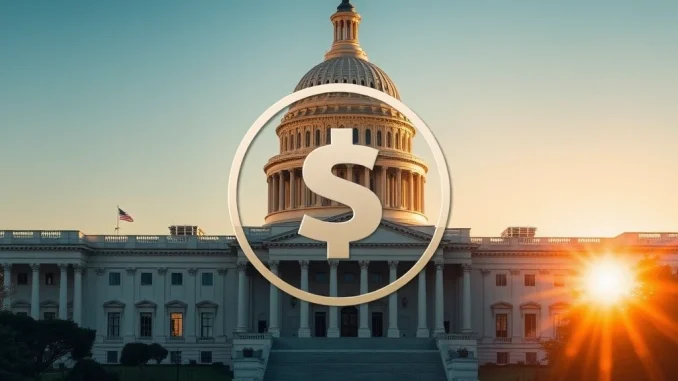
Exciting news for the crypto world! U.S. Senator Kirsten Gillibrand has ignited a spark of optimism in the digital asset space, suggesting that long-awaited stablecoin regulation in the United States might finally be on the horizon. Could this be the breakthrough the industry has been waiting for? Let’s dive into the details of this potentially game-changing development.
Why is Urgent Stablecoin Regulation Needed?
Senator Gillibrand, speaking at the DC Blockchain Summit, emphasized the pressing need for a robust regulatory framework for stablecoins. She pointed to recent financial tremors – the collapse of the FTX crypto exchange in 2022 and the unsettling events surrounding Silicon Valley Bank in 2023 – as stark reminders of the vulnerabilities within the digital asset ecosystem. These events underscored the critical importance of investor protection and the need to foster innovation responsibly. Without clear rules, the U.S. risks stifling growth and leaving investors exposed to unnecessary risks. Think of it like this: stablecoins, designed to be pegged to fiat currencies like the US dollar, are meant to be anchors in the often-volatile crypto sea. But without proper regulation, these anchors can drag, potentially destabilizing the entire system.
Here’s why strong stablecoin regulation is not just beneficial, but absolutely essential:
- Investor Protection: Clear rules build trust and protect individuals and institutions investing in stablecoins from potential fraud and market manipulation.
- Market Stability: Regulation can help prevent events like ‘bank runs’ on stablecoins, ensuring a more stable and predictable crypto market.
- Innovation and Growth: A well-defined regulatory landscape provides clarity for businesses, encouraging innovation and investment in the crypto space within the U.S., rather than pushing it offshore.
- Financial System Integration: As crypto becomes more intertwined with traditional finance, regulation is crucial for ensuring the stability and integrity of the broader financial system.
US Crypto Regulation: A Patchwork System Seeking Harmony
The current state of US crypto regulation is often described as a patchwork – a mix of state and federal guidelines, with significant gaps and overlaps. This lack of clarity has created confusion and uncertainty for businesses operating in the crypto space. Senator Gillibrand’s comments suggest a potential shift towards a more unified and comprehensive federal approach, particularly concerning stablecoins. This is a welcome development for many in the industry who have been advocating for clearer rules of the road. Imagine trying to navigate a complex city without street signs – that’s essentially what operating in the unregulated crypto space can feel like. Consistent US crypto regulation would provide those much-needed street signs, guiding businesses and fostering responsible growth.
The Stablecoin Bill: A Glimmer of Hope Before Easter?
The burning question is: when can we expect this crucial stablecoin bill to become a reality? Senator Gillibrand has offered a promising timeline, suggesting that there’s a real possibility of passage before the Easter recess. While she acknowledges that legislative timelines can be unpredictable, she expressed strong confidence that if it doesn’t happen by Easter, it will “definitely” pass before the summer break. This optimistic outlook is significant, especially considering the prolonged discussions and debates surrounding crypto regulation in Washington D.C. The prospect of a stablecoin bill moving forward in the near future is injecting a renewed sense of hope into the crypto community. This potential legislative progress could mark a turning point, signaling a more proactive and supportive stance from the U.S. government towards the digital asset industry.
Decoding Crypto Legislation: What to Expect in the Stablecoin Bill?
While the specifics of the crypto legislation, particularly the stablecoin bill, are still being finalized, Senator Gillibrand has provided some insights. She emphasized that a “simplified” version of the bill would be insufficient. In her view, a robust and comprehensive approach is necessary to truly protect consumers and foster a thriving crypto industry. She highlighted the importance of learning from past failures, implying that the bill will likely include measures to prevent similar incidents in the future. Furthermore, she mentioned the GENIUS Act, which reportedly includes several provisions aimed at consumer protection. It’s reasonable to expect that the crypto legislation will address key areas such as:
- Reserve Requirements: Ensuring stablecoin issuers hold adequate reserves to back their tokens, guaranteeing redemption at par value.
- Disclosure and Transparency: Requiring stablecoin issuers to provide clear and regular disclosures about their reserves and operations.
- Regulatory Oversight: Establishing which regulatory bodies will oversee stablecoin issuers and enforce compliance.
- Consumer Protection Measures: Implementing safeguards to protect users from fraud, manipulation, and other risks associated with stablecoins.
Digital Asset Regulation: A Global Race for Clarity
The push for digital asset regulation is not confined to the United States. Globally, governments are grappling with how to effectively regulate cryptocurrencies and stablecoins. The European Union has made significant strides with its Markets in Crypto-Assets (MiCA) regulation, and other jurisdictions are actively developing their own frameworks. The U.S.’s approach to digital asset regulation will not only shape its domestic crypto industry but also influence the global regulatory landscape. Getting it right is crucial for maintaining the U.S.’s position as a leader in innovation and finance. The passage of a comprehensive stablecoin bill would send a powerful message to the world that the U.S. is serious about embracing the potential of digital assets while mitigating the associated risks.
Benefits of Strong Stablecoin Regulation
- Boosted Investor Confidence: Clear rules will attract more institutional and retail investors to the crypto market.
- Reduced Systemic Risk: Regulation will minimize the potential for stablecoin failures to impact the broader financial system.
- Level Playing Field: Fair and consistent rules will create a more equitable environment for crypto businesses to compete and thrive.
- Enhanced Innovation: Clarity will encourage responsible innovation and the development of new and beneficial crypto applications.
- Global Leadership: Proactive regulation will position the U.S. as a leader in the responsible development and adoption of digital assets.
Challenges in Implementing Stablecoin Regulation
- Complexity of Crypto: Regulating a rapidly evolving and complex technology like crypto is inherently challenging.
- Inter-Agency Coordination: Effective regulation requires coordination between various government agencies with different areas of expertise.
- Balancing Innovation and Protection: Finding the right balance between fostering innovation and protecting consumers and the financial system is crucial.
- Enforcement Challenges: Ensuring compliance and effectively enforcing regulations in the decentralized crypto space can be complex.
- Global Coordination: Harmonizing regulations across different jurisdictions is essential for a truly effective global framework.
Conclusion: A Crucial Step Towards Mainstream Crypto Adoption
Senator Gillibrand’s optimistic forecast for the stablecoin bill is a welcome development for the crypto industry. The passage of comprehensive and well-thought-out regulation is not just about controlling risks; it’s about unlocking the full potential of stablecoins and the broader digital asset ecosystem. By providing clarity, fostering trust, and encouraging responsible innovation, the U.S. can solidify its position as a hub for crypto innovation and pave the way for wider mainstream adoption. The coming months could be pivotal for the future of crypto in the United States, and the world will be watching closely.



